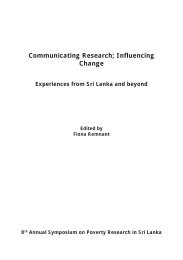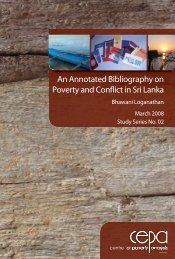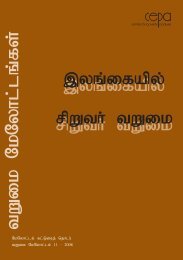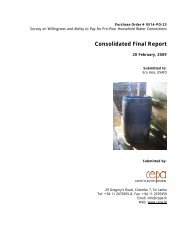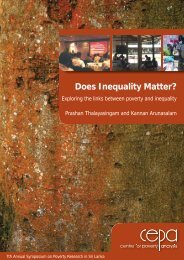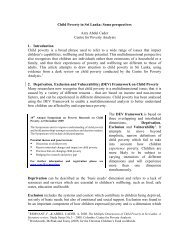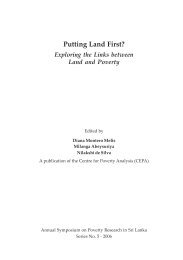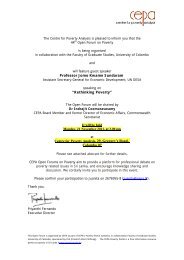Involuntary Displacement and Resettlement â Policy and ... - CEPA
Involuntary Displacement and Resettlement â Policy and ... - CEPA
Involuntary Displacement and Resettlement â Policy and ... - CEPA
- No tags were found...
Create successful ePaper yourself
Turn your PDF publications into a flip-book with our unique Google optimized e-Paper software.
people becoming forced migrants; losing their homes, walking through thejungle or fleeing by boat in rough seas during the monsoon rain. People inPuttalam similarly experienced becoming hosts when welcoming their Muslimbrothers <strong>and</strong> sisters. The Islamic discourse of hospitality played a crucial partin this. Later, the humanitarian discourse of internal displacement, asexpressed by the UN/Brookings approach – <strong>and</strong> which the situation in SriLanka during the 1990s played a crucial part in developing – became thedominant discourse of internal displacement. These practices <strong>and</strong> discoursesworked together to create what the IDP <strong>and</strong> host categories mean inPuttalam today. Contributing to these changes are the dynamics between theIDPs <strong>and</strong> hosts, <strong>and</strong> within the groups of IDPs <strong>and</strong> hosts, as well as thechanging policies towards IDPs <strong>and</strong> hosts by the government <strong>and</strong>humanitarian agencies. For example, the northern Muslims were very quick inorganising themselves <strong>and</strong> advocating for their interests based on theircommon identity as displaced. Even today this is important. As a group, theIDPs can appear as almost stronger than the hosts, who to a large extenthave lost their importance in the humanitarian discourse <strong>and</strong> consequentlyhave little influence with humanitarian agencies <strong>and</strong> government institutionsset up to assist IDPs. This has created complex power relationships betweenthe two groups.I have briefly showed how the categories of ‘IDPs’ <strong>and</strong> ‘hosts’ were formed<strong>and</strong> has been transformed. Thayalasingam (this volume), in his paper, showshow these groups develop conflictual relationships. I would like to go onestep further here, <strong>and</strong> come back to the processes of labelling to look intosome of the reasons for these conflicts. I would like to focus on the so-called1) homogenising effect; 2) the privileging effect; 3) the localising effect; <strong>and</strong>4) politicisation <strong>and</strong> de-politicisation.1) The homogenising effect: The homogenising effect is a majorissue <strong>and</strong> challenge when we formulate categories. Labelling createscategories that tend to treat all individuals in that category in the sameway. We do not see that some people gain <strong>and</strong> some lose from theforced migration processes. It becomes more challenging to identifyvulnerability among the two groups of IDPs <strong>and</strong> hosts. When a situationbecomes protracted, as in the case of Puttalam, the labelsdevelop into social groups. IDPs <strong>and</strong> hosts have become social groupsthat contribute to the way society is organised.2) The privileging effect: The homogenising effect is closely relatedto the privileging effect. Categories include some <strong>and</strong> exclude others.Labelling some people as ‘IDPs’ means that those who are supposed to137



